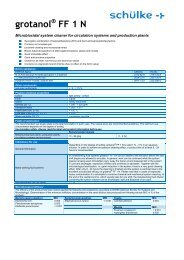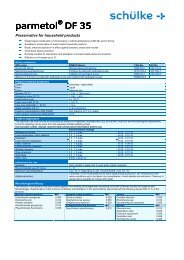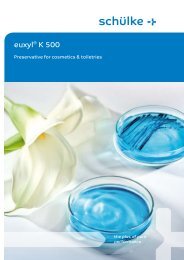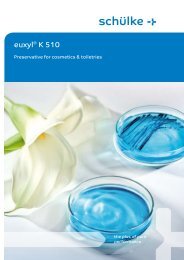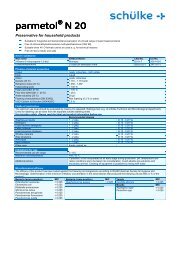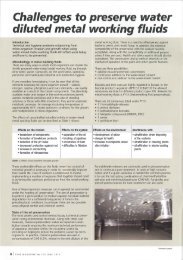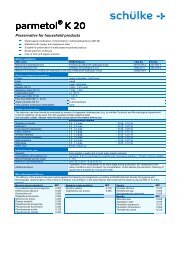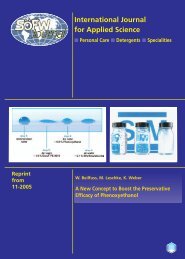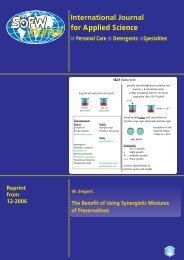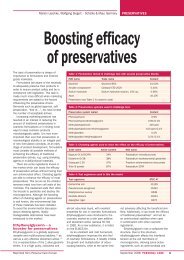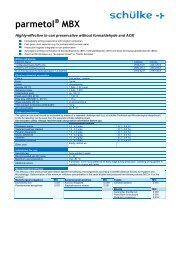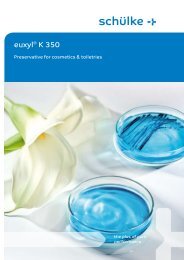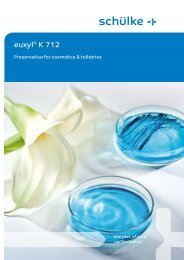Sustainable Use of Preservatives in Wet Cleaning ... - Schülke & Mayr
Sustainable Use of Preservatives in Wet Cleaning ... - Schülke & Mayr
Sustainable Use of Preservatives in Wet Cleaning ... - Schülke & Mayr
You also want an ePaper? Increase the reach of your titles
YUMPU automatically turns print PDFs into web optimized ePapers that Google loves.
<strong>Susta<strong>in</strong>able</strong> <strong>Use</strong> <strong>of</strong> <strong>Preservatives</strong> <strong>in</strong><strong>Wet</strong> Clean<strong>in</strong>g WipesModern preservative systems must balance market<strong>in</strong>g andproduction demands to create eco–friendly products.By Wolfgang Siegert,Technical Support Manager InternationalSchülke & <strong>Mayr</strong> GmbHSpecial Additives InternationalConsumers have come to expect certa<strong>in</strong> key attributesfrom wet clean<strong>in</strong>g wipes relative to their <strong>in</strong>tendeduse, such as soil removal capacity, anti-static properties,streak-free sh<strong>in</strong>e, etc. Additionally, environmentalacceptability, <strong>in</strong>clud<strong>in</strong>g the susta<strong>in</strong>able use <strong>of</strong> raw materials,is becom<strong>in</strong>g a decisive factor for many customers.The synergistic comb<strong>in</strong>ation <strong>of</strong> benzisothiazol<strong>in</strong>one(BIT), methylisothiazol<strong>in</strong>one (MIT) and bis(3-am<strong>in</strong>opropyl)dodecylam<strong>in</strong>e(BDA) has been shown to m<strong>in</strong>imizethe level <strong>of</strong> biocidal actives needed for preservation. Withthis new susta<strong>in</strong>able “full-life” protection concept, it ispossible to control waterborne contam<strong>in</strong>ations andmicrobially polluted natural nonwovens by add<strong>in</strong>g a s<strong>in</strong>gle,optimized dosage <strong>of</strong> preservative. Along with the economicand product safety improvements, this approachfulfills the demand for eco-labels, like European Flowerand the White Swan, as well as the str<strong>in</strong>gent requirements<strong>of</strong> the German Öko Test magaz<strong>in</strong>e.The Goal <strong>of</strong> ‘Green’ ProductsSusta<strong>in</strong>ability is be<strong>in</strong>g systematically <strong>in</strong>tegrated <strong>in</strong>tomany companies’ pr<strong>in</strong>ciples and bus<strong>in</strong>ess processes.Often, the use <strong>of</strong> biocides is an essential po<strong>in</strong>t <strong>of</strong> discussion.Despite some consumer concerns about theuse <strong>of</strong> biocides, the use <strong>of</strong> these materials has enableda shift toward products with greater biodegradability. Ina sense, the value <strong>of</strong> biocides to the quality <strong>of</strong> our livesis beyond price. Their function is preventative, primarily,m<strong>in</strong>imiz<strong>in</strong>g waste <strong>of</strong> natural and limited resources whilereduc<strong>in</strong>g exposure to harmful microorganisms.The wish to produce “green” products should notresult <strong>in</strong> <strong>in</strong>sufficiently preserved, unsafe products.Proliferation <strong>of</strong> pathogenic microorganisms, productspoilage and visible growth <strong>of</strong> mold on the wet wipes arethe risk <strong>of</strong> <strong>in</strong>adequately protected products.Microorganisms live <strong>in</strong> all parts <strong>of</strong> the biosphere wherethere is liquid water; they are critical to nutrient recycl<strong>in</strong>g<strong>in</strong> ecosystems as they act as decomposers. Populations<strong>of</strong> microorganisms undergo exponential growth. Figure 1demonstrates the growth <strong>of</strong> Escherichia coli at optimalconditions with a generation time <strong>of</strong> 20 m<strong>in</strong>utes.<strong>Wet</strong> tissues are an excellent medium for the growth<strong>of</strong> bacteria, yeast and mold. The wet tissue liquids aremostly aqueous; the cellulose is a good nutrient; thenonwoven is always moderately contam<strong>in</strong>ated withmicroorganisms; and the storage temperature is nearlyFigure 1Exponential growth <strong>of</strong> microorganisms <strong>in</strong> water (generation time 20m<strong>in</strong>).optimal for microbial growth. Environmental requirements(e.g., from the EU Detergent Directive) to use onlybiodegradable detergents <strong>in</strong>crease the susceptibility <strong>of</strong>wet tissues to microbial <strong>in</strong>fection. The demand for flushablewipes and the <strong>in</strong>creased use <strong>of</strong> natural fibers makemold growth, with its easily visible sta<strong>in</strong><strong>in</strong>g, more likely.To ensure consumer safety and product stability, theaddition <strong>of</strong> preservatives to wet wipes is necessary.<strong>Preservatives</strong> should protect the product by prevent<strong>in</strong>gbiological degradation for a certa<strong>in</strong> period. However, atthe end <strong>of</strong> the lifecycle <strong>of</strong> a wet wipe (the disposal) thebiocide should be biodegradable.Biocidal properties and biodegradability are not <strong>in</strong>26 HOUSEHOLD &PERSONAL CARE WIPES/FALL 2012
conflict. For example, a concentration <strong>of</strong> ethanolbetween 50% and 90% is a good dis<strong>in</strong>fectant. It actsbetween 13% and 50% as preservative. Below 13%ethanol will be degraded biologically to acetic acid.Conflict & BalanceFrom a market<strong>in</strong>g perspective, preservation should beas “green” as possible. Some consumers would preferpreservative-free.From the view <strong>of</strong> plant management, preservationshould control any microbial contam<strong>in</strong>ation dur<strong>in</strong>g production.This would save costs for clean<strong>in</strong>g and sanitiz<strong>in</strong>g.ISO 22716 (Cosmetics—Good Manufactur<strong>in</strong>gPractices (GMP)—Guidel<strong>in</strong>es on Good Manufactur<strong>in</strong>gPractices) gives guidel<strong>in</strong>es for the production, control,storage and shipment <strong>of</strong> cosmetic wipes. While manufactur<strong>in</strong>g<strong>in</strong> a simpler production l<strong>in</strong>e, ignor<strong>in</strong>g hygienicdesign, may be acceptable for hard surface clean<strong>in</strong>gwipes, it is advisable to follow the same GMP rules forthe manufacture <strong>of</strong> cosmetic wipes to m<strong>in</strong>imize potentialmicrobial contam<strong>in</strong>ation.The target for product development is to select a preservativesystem balanc<strong>in</strong>g market<strong>in</strong>g and productiondemands to achieve an eco–friendly, susta<strong>in</strong>able product.Contam<strong>in</strong>ation SourcesMicrobial contam<strong>in</strong>ation <strong>of</strong> wet wipes can occur dur<strong>in</strong>gtheir manufacture. The majority <strong>of</strong> the contam<strong>in</strong>ants arepresent <strong>in</strong> the source <strong>of</strong> water and <strong>in</strong> the raw materials,<strong>in</strong>clud<strong>in</strong>g the nonwoven as well as <strong>in</strong> equipment andplumb<strong>in</strong>g l<strong>in</strong>es (tanks and pipes). Certa<strong>in</strong> microorganismsproduce bi<strong>of</strong>ilms that can adhere to the surfaces <strong>of</strong>plumb<strong>in</strong>g systems conta<strong>in</strong><strong>in</strong>g water, to process<strong>in</strong>g tanksand to other environments <strong>in</strong> the factory. These bi<strong>of</strong>ilmsare <strong>in</strong> general resistant to treatment with biocides.The <strong>in</strong>com<strong>in</strong>g water <strong>in</strong> factory pipe systems can orig<strong>in</strong>atefrom various sources. Each source supplies a different,usually specific composition <strong>of</strong> organic and <strong>in</strong>organicconstituents <strong>of</strong> chemical <strong>in</strong>gredients <strong>in</strong> the water.Additionally, the hardness <strong>of</strong> the water can play animportant role. Possible water sources <strong>in</strong>clude:• Town water from a s<strong>in</strong>gle public well• Town water from various public wells• Water from (river) shore filtrates• Water from (sea) shore filtrates• Water from reservoirs• Water from a privately owned source• Water from a privately owned wellIon exchangers are <strong>of</strong>ten sources <strong>of</strong> contam<strong>in</strong>ation. Theion exchanger res<strong>in</strong>s can be colonized by bi<strong>of</strong>ilms, which areunharmed even after regeneration with sodium hydroxideFigure 2Optimized dosage concept for a fast-act<strong>in</strong>g <strong>in</strong>-can preservative.solution or hydrochloric acid. An exchanger plant fed withdr<strong>in</strong>k<strong>in</strong>g water (organism count
ial challenge test<strong>in</strong>g (schülke FeuTukoTest) us<strong>in</strong>g thispreservative comb<strong>in</strong>ation.Labels & LegislationThe European Ecolabel is a voluntary scheme established<strong>in</strong> 1992 to encourage bus<strong>in</strong>esses to market eco-friendlyproducts and services. Products and services awardedthe Ecolabel carry the flower logo, allow<strong>in</strong>g consumers,both public and private—to identify them easily.Established product groups <strong>in</strong>clude all-purpose cleanersand cleaners for sanitary facilities;detergents for dishwash<strong>in</strong>g mach<strong>in</strong>es;hand dishwash<strong>in</strong>g detergents; laundrydetergents and soaps, shampoos andhair conditioners.The ecological criteria required toreceive the EU Ecolabel for all-purposecleaners and sanitary cleaners are published<strong>in</strong> the Commission Decision2011/383/EU.The formulation shown <strong>in</strong> Figure 3would fulfill the demands <strong>of</strong> thisCommission Decision. Additionally, thepackag<strong>in</strong>g criteria for these productsmust be taken <strong>in</strong>to account. Accord<strong>in</strong>gto the European Chemicals Agency(ECHA) “Guidance on requirements forsubstances <strong>in</strong> articles,” a wet clean<strong>in</strong>gwipe is a comb<strong>in</strong>ation <strong>of</strong> an article(function<strong>in</strong>g as a conta<strong>in</strong>er or a carriermaterial) and a substance or mixture.For such ready-to-use products, theweight utility ratio (WUR) <strong>of</strong> the primarypackag<strong>in</strong>g must be below 150 gramspackag<strong>in</strong>g per liter <strong>of</strong> clean<strong>in</strong>g solution.For example, with a 120 grams persquare-meter spunlace three-layer structure(67% viscose, 33% PET, sawatexTriLace), a maximum water absorptioncapacity <strong>of</strong> approximately 1,000% is possible8 . In practice, it was found that theactual absorption capacity was 830%.This allows for the application <strong>of</strong> 1,000grams <strong>of</strong> clean<strong>in</strong>g solution on 120 grams<strong>of</strong> nonwoven, so there is still some spacefor a s<strong>of</strong>t pack. Production <strong>of</strong> an Ecolabelconform<strong>in</strong>gwet wipe product is possible.In Summary…A limited number <strong>of</strong> biocidal activesare available for the preservation <strong>of</strong>household wet clean<strong>in</strong>g wipes. Manyactives are under public discussionand harsh actives may lead to negativereviews <strong>in</strong> test magaz<strong>in</strong>es. Newconcepts <strong>in</strong> preservation are required.28 HOUSEHOLD &PERSONAL CARE WIPES/FALL 2012
M<strong>in</strong>imiz<strong>in</strong>g the use <strong>of</strong> preservativesis essential accord<strong>in</strong>g to the philosophy“as little as possible, but asmuch as technically necessary.”The utilization <strong>of</strong> boost<strong>in</strong>g effects<strong>of</strong> actives helps to reduce use concentrations.An optimized dosageconcept improves and helps toensure product safety, even with lowuse concentrations <strong>of</strong> <strong>in</strong>-can preservatives.Optimized preservativeapplication, comb<strong>in</strong>ed with specialnonwoven qualities, allow productsto fulfill EU Ecolabel criteria. HPCWAbout the author: Wolfgang Siegertis technical support manager withSchülke & <strong>Mayr</strong> GmbH. He can bereached at +49 40 52100 528;wolfgang.siegert@schuelke.com;www.schuelke.com.Figure 3All-purpose wet wipe that passes microbial challenge test.there’s only so much land to meet the needs <strong>of</strong> our ever-expand<strong>in</strong>gpopulation. luckily, cotton is a crop that provides both fiber and foodsimultaneously. cottonseed oil is used <strong>in</strong> the commercial food <strong>in</strong>dustry.whole cottonseed is fed to dairy cows, and <strong>in</strong> the future, it could feed other livestockand even people. so, when you choose to put cotton <strong>in</strong> your nonwovens, it’s not achoice between fiber or food. cotton provides both. visit cotton<strong>in</strong>c.com/nonwovensto f<strong>in</strong>d out more about your cotton nonwoven options.AMERICA’S COTTON PRODUCERS AND IMPORTERS. Service Marks/Trademarks <strong>of</strong> Cotton Incorporated. © 2012 Cotton Incorporated.HOUSEHOLD &PERSONAL CARE WIPES/FALL 2012 29



